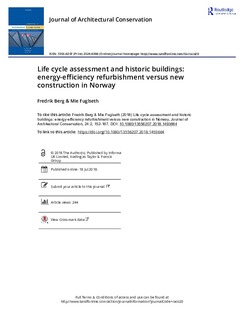| dc.contributor.author | Berg, Fredrik | |
| dc.contributor.author | Fuglseth, Mie Sparby | |
| dc.date.accessioned | 2018-08-09T12:52:04Z | |
| dc.date.available | 2018-08-09T12:52:04Z | |
| dc.date.created | 2018-05-15T09:45:41Z | |
| dc.date.issued | 2018 | |
| dc.identifier.citation | Journal of Architectural Conservation. 2018, 24 (2), 152-167. | nb_NO |
| dc.identifier.issn | 1355-6207 | |
| dc.identifier.uri | http://hdl.handle.net/11250/2508272 | |
| dc.description.abstract | Refurbishment policies for the historic segment of the building stock must be carefully promoted in the process of addressing the transition to a low-emission society to avoid the loss of the values which make this heritage significant. This article presents and the results of a Norwegian life cycle assessment comparing the net climate benefits from the refurbishment of a residential building from the 1930s with the construction of a new building in accordance with modern building codes. The results show that a careful refurbishment of the historic building is favourable in a climate change mitigation perspective over a 60-year period of analysis. For the new building, it takes more than 50 years for the initial emissions from construction to be outweighed by the effects of lower in-use energy consumption. The results underline the significance of emissions from the use of materials in the refurbishment process and that residents play a critical part with respect to realising the expected energy savings. It is concluded that material use and user behaviour have a crucial impact on greenhouse gas emissions in a life cycle perspective and that the continued use of historic buildings should be advocated for in building codes and environmental policies. | nb_NO |
| dc.language.iso | eng | nb_NO |
| dc.publisher | Informa UK Limited, trading as Taylor & Francis Group | nb_NO |
| dc.rights | Attribution-NonCommercial-NoDerivatives 4.0 Internasjonal | * |
| dc.rights.uri | http://creativecommons.org/licenses/by-nc-nd/4.0/deed.no | * |
| dc.subject | life cycle assessment (LCA) | nb_NO |
| dc.subject | energy efficiency | nb_NO |
| dc.subject | historic buildings | nb_NO |
| dc.subject | building conservation | nb_NO |
| dc.subject | climate change | nb_NO |
| dc.title | Life cycle assessment and historic buildings: energy efficiency refurbishment versus new construction in Norway Journal of Architectural Conservation | nb_NO |
| dc.type | Journal article | nb_NO |
| dc.type | Peer reviewed | nb_NO |
| dc.description.version | publishedVersion | nb_NO |
| dc.rights.holder | © 2018 The Author(s). | nb_NO |
| dc.source.pagenumber | 152-167 | nb_NO |
| dc.source.volume | 24 | nb_NO |
| dc.source.journal | Journal of Architectural Conservation | nb_NO |
| dc.source.issue | 2 | nb_NO |
| dc.identifier.doi | https://www.tandfonline.com/doi/full/10.1080/13556207.2018.1493664 | |
| dc.identifier.cristin | 1585009 | |
| cristin.unitcode | 7530,42,0,0 | |
| cristin.unitname | Bygningsavdelingen | |
| cristin.ispublished | false | |
| cristin.fulltext | original | |
| cristin.qualitycode | 2 | |

